High-Density Communities and Infectious Disease Vulnerability: A Built Environment Perspective for Sustainable Health Development
Abstract
:1. Introduction
2. Methods
2.1. Index Selection
2.2. Theoretical Overview
2.3. Research Region and Data Sources
2.4. Statistical Analyzing
2.4.1. Calculation of Indicators
2.4.2. Correlation Analysis
2.4.3. Regression Analysis
3. Results
3.1. Spatial Patterns of COVID-19 Infections and BEs in Shenzhen Communities
3.2. Relationship between the Community Epidemic Incidence and Built Environment
3.3. GLM Regression Results for General Communities
3.4. GLM Regression Results for High-Density Communities
4. Discussion
4.1. Analysis of Shenzhen’s Epidemic Distribution Patterns and BE Characteristics
4.2. Built Environment Factors Affecting COVID-19 Cases in High-Density Communities
4.3. Comparative Analysis between High-Density Communities and General Communities
4.4. Guidance on the Built Environment Design of High-Density Communities
5. Conclusions
Author Contributions
Funding
Data Availability Statement
Conflicts of Interest
References
- Pinter-Wollman, N.; Jelić, A.; Wells, N.M. The Impact of the Built Environment on Health Behaviours and Disease Transmission in Social Systems. Philos. Trans. R. Soc. B Biol. Sci. 2018, 373, 20170245. [Google Scholar] [CrossRef] [PubMed]
- Ma, J.; Xu, J.; Zhao, X.; Huo, S.; Duan, X.; Mu, Y.; Wang, Y.; Wei, Y.; Chang, J.; Jin, X.; et al. Several major issues concern-ing the environmental transmission and risk prevention of SARS-CoV-2. Sci. China Earth Sci. 2022, 65, 1047–1056. [Google Scholar] [CrossRef] [PubMed]
- Wu, X.; Tian, H.; Zhou, S.; Chen, L.; Xu, B. Impact of global change on transmission of human infectious diseases. Sci. China Earth Sci. 2014, 57, 189–203. [Google Scholar] [CrossRef] [PubMed]
- Neiderud, C.-J. How Urbanization Affects the Epidemiology of Emerging Infectious Diseases. Infect. Ecol. Epidemiol. 2015, 5, 27060. [Google Scholar] [CrossRef] [PubMed]
- Woolhouse, M.E.J.; Gowtage-Sequeria, S. Host range and emerging and reemerging pathogens. Emerg. Infect. Dis. 2005, 11, 1842–1847. [Google Scholar] [CrossRef]
- Adams, R.I.; Bhangar, S.; Dannemiller, K.C.; Eisen, J.A.; Fierer, N.; Gilbert, J.A.; Green, J.L.; Marr, L.C.; Miller, S.L.; Siegel, J.A.; et al. Ten Questions Concerning the Microbiomes of Buildings. Build. Environ. 2016, 109, 224–234. [Google Scholar] [CrossRef]
- Glaeser, E. Cities, Productivity, and Quality of Life. Science 2011, 333, 592–594. [Google Scholar] [CrossRef]
- Bodea, C.N.; Purnus, A. Legal implications of adopting Building Information Modeling (BIM). Jurid. Trib.-Trib. Jurid. 2018, 8, 63–72. [Google Scholar]
- Li, H.; Liu, Z. Temporal and Spatial Evolution of Urban Density in China and Analysis of Urban High Density Development: From 1981 to 2014. Urban Dev. Studies. 2019, 26, 46–54. [Google Scholar]
- Shi, B.; Marvin, S.; Yang, J. Study on Quality Improvement of Built Environment in High-density Urban Areas Under the Background of Post Smart City Transformation. Urban Plan. Int. 2021, 36, 16–21. [Google Scholar] [CrossRef]
- Yao, Y.; Pan, H.; Cui, X.; Wang, Z. Do Compact Cities Have Higher Efficiencies of Agglomeration Economies? A Dynamic Panel Model with Compactness Indicators. Land Use Policy 2022, 115, 106005. [Google Scholar] [CrossRef]
- Correia, S.; Luck, S.; Verner, E. Pandemics Depress the Economy, Public Health Interventions Do Not: Evidence from the 1918 Flu. J. Econ. Hist. 2022, 82, 917–957. [Google Scholar] [CrossRef]
- Wang, Z.; Zhang, Y. Review on the Relationship between High-density Built Environment and Public Health. South Archit. 2023, 6, 21–31. Available online: https://kns.cnki.net/kcms/detail/44.1263.TU.20230406.1325.008.html (accessed on 20 April 2022).
- Duan, J.; Zhang, J.; Chai, Y.; Zhai, G.; Li, Z.; Tan, Z.; Yang, D.; Yang, J.; Yuan, Y.; Liu, W.; et al. “What lesson does COVID-19 teach planning?” Aca-demic writing. Urban Plan. Forum. 2022, 3, 1–10. [Google Scholar] [CrossRef]
- Allam, Z.; Jones, D.S. Pandemic Stricken Cities on Lockdown. Where Are Our Planning and Design Professionals [Now, Then and into the Future]? Land Use Policy 2020, 97, 104805. [Google Scholar] [CrossRef] [PubMed]
- Deng, L.; Wang, L. The Impact of Urban Expansion and High Density on Infectious Diseases and Planning Strategies. New Archit. 2021, 6, 88–93. [Google Scholar] [CrossRef]
- Li, X.; Zhou, L.; Jia, T.; Peng, R.; Fu, X.; Zou, Y. Associating COVID-19 Severity with Urban Factors: A Case Study of Wuhan. Int. J. Environ. Res. Public. Health 2020, 17, 6712. [Google Scholar] [CrossRef] [PubMed]
- Kan, Z.; Kwan, M.-P.; Wong, M.S.; Huang, J.; Liu, D. Identifying the Space-Time Patterns of COVID-19 Risk and Their Associations with Different Built Environment Features in Hong Kong. Sci. Total Environ. 2021, 772, 145379. [Google Scholar] [CrossRef]
- Wang, J.; Zeng, F.; Tang, H.; Wang, J.; Xing, L. Correlations between the Urban Built Environmental Factors and the Spatial Distribution at the Community Level in the Reported COVID-19 Samples: A Case Study of Wuhan. Cities 2022, 129, 103932. [Google Scholar] [CrossRef]
- Zheng, T.; Liu, H. Exploration of the Built-Environmental Elements that Influence the Spread of COVID19 Pandemic on Community Scale: A Case Study of Wuhan, China. Mod. Urban Res. 2020, 10, 20–29. [Google Scholar] [CrossRef]
- Campello, M.; Kankanhalli, G.; Muthukrishnan, P. Corporate Hiring Under COVID-19: Financial Constraints and the Nature of New Jobs. J. Financ. Quant. Anal. 2023, Published online, 1–45. [Google Scholar] [CrossRef]
- Tribby, C.P.; Hartmann, C. COVID-19 Cases and the Built Environment: Initial Evidence from New York City. Prof. Geogr. 2021, 73, 365–376. [Google Scholar] [CrossRef]
- Guo, Y.; Yu, H.; Zhang, G.; Ma, D.T. Exploring the Impacts of Travel-Implied Policy Factors on COVID-19 Spread within Communities Based on Multi-Source Data Interpretations. Health Place 2021, 69, 102538. [Google Scholar] [CrossRef] [PubMed]
- Guan, C.; Tan, J.; Li, Y.; Cheng, T.; Yang, J.; Liu, C.; Keith, M. How do density, employment and transit affect the prevalence of COVID-19 pandemic? A study of 3,141 counties across the United States. Health Place 2023, 84, 103117. [Google Scholar] [CrossRef] [PubMed]
- Nguyen, Q.C.; Huang, Y.; Kumar, A.; Duan, H.; Keralis, J.M.; Dwivedi, P.; Meng, H.-W.; Brunisholz, K.D.; Jay, J.; Javanmardi, M.; et al. Using 164 Million Google Street View Images to Derive Built Environment Predictors of COVID-19 Cases. Int. J. Environ. Res. Public. Health 2020, 17, 6359. [Google Scholar] [CrossRef] [PubMed]
- Zhou, W. Research on the Correlation between Urban Built Environment and High-risk Communities under Epidemic Situation Based on the Sample of Seven Urban Communities in Hankou. New Archit. 2020, 6, 52–55. [Google Scholar] [CrossRef]
- Rahman, M.H.; Zafri, N.M.; Ashik, F.R.; Waliullah, M.; Khan, A. Identification of Risk Factors Contributing to COVID-19 Incidence Rates in Bangladesh: A GIS-Based Spatial Modeling Approach. Heliyon 2021, 7, e06260. [Google Scholar] [CrossRef]
- Credit, K. Neighbourhood Inequity: Exploring the Factors Underlying Racial and Ethnic Disparities in COVID-19 Testing and Infection Rates Using ZIP Code Data in Chicago and New York. Reg. Sci. Policy Pract. 2020, 12, 1249–1271. [Google Scholar] [CrossRef]
- Wang, L.; Hu, Z.; Zhou, K.; Kwan, M.-P. Identifying spatial heterogeneity of COVID-19 transmission clusters and their built-environment features at the neighbourhood scale. Health Place 2023, 84, 103130. [Google Scholar] [CrossRef]
- Li, B.; Liu, Q.; He, H.; Peng, Y. The Influence of Urban Built Environment on COVID-19 Epidemic and Its Prevention and Control Measures. Chin. Overseas Archit. 2021, 12, 2–7. [Google Scholar] [CrossRef]
- Li, B.; Peng, Y.; He, H.; Wang, M.; Feng, T. Built Environment and Early Infection of COVID-19 in Urban Districts: A Case Study of Huangzhou. Sustain. Cities Soc. 2021, 66, 102685. [Google Scholar] [CrossRef] [PubMed]
- Li, W.; Zhao, S.-C.; Ji, X.-F.; Ma, J.-W. Impact of Traffic Exposure and Land Use Patterns on the Rick of COVID-19 Spread at the Community Level. China J. Highw. Transp. 2020, 33, 43–54. [Google Scholar] [CrossRef]
- Duan, J.; Yang, B.; Zhou, L.; Zhang, J. Planning Improves City’s Immunity: A Written Conversa-tion on COVID-19 Breakout. City Plan. Rev. 2020, 44, 115–136. [Google Scholar]
- Ewing, R.; Cervero, R. Travel and the Built Environment: A Meta-Analysis. J. Am. Plann. Assoc. 2010, 76, 265–294. [Google Scholar] [CrossRef]
- Wali, B.; Frank, L.D. Neighborhood-Level COVID-19 Hospitalizations and Mortality Relationships with Built Environment, Active and Sedentary Travel. Health Place 2021, 71, 102659. [Google Scholar] [CrossRef] [PubMed]
- Bin Kashem, S.; Baker, D.M.; González, S.R.; Lee, C.A. Exploring the Nexus between Social Vulnerability, Built Environment, and the Prevalence of COVID-19: A Case Study of Chicago. Sustain. Cities Soc. 2021, 75, 103261. [Google Scholar] [CrossRef] [PubMed]
- Huang, X.; Yang, Q.; Yang, J. Importance of Community Containment Measures in Combating the COVID-19 Epidemic: From the Perspective of Urban Planning. Geo-Spat. Inf. Sci. 2021, 24, 363–371. [Google Scholar] [CrossRef]
- Niu, Q.; Wu, W.; Shen, J.; Huang, J.; Zhou, Q. Relationship between Built Environment and COVID-19 Dispersal Based on Age Stratification: A Case Study of Wuhan. Int. J. Environ. Res. Public. Health 2021, 18, 7563. [Google Scholar] [CrossRef]
- Asfour, O.S. Housing Experience in Gated Communities in the Time of Pandemics: Lessons Learned from COVID-19. Int. J. Environ. Res. Public. Health 2022, 19, 1925. [Google Scholar] [CrossRef]
- DiMaggio, C.; Klein, M.; Berry, C.; Frangos, S. Black/African American Communities Are at Highest Risk of COVID-19: Spatial Modeling of New York City ZIP Code-Level Testing Results. Ann. Epidemiol. 2020, 51, 7–13. [Google Scholar] [CrossRef]
- Xu, Y.; Guo, C.; Yang, J.; Yuan, Z.; Ho, H.C. Modelling Impact of High-Rise, High-Density Built Environment on COVID-19 Risks: Empirical Results from a Case Study of Two Chinese Cities. Int. J. Environ. Res. Public. Health 2023, 20, 1422. [Google Scholar] [CrossRef] [PubMed]
- Tepe, E. The Impact of Built and Socio-Economic Environment Factors on Covid-19 Transmission at the ZIP-Code Level in Florida. J. Environ. Manag. 2023, 326, 116806. [Google Scholar] [CrossRef] [PubMed]
- Liu, C.; Liu, Z.; Guan, C. The Impacts of the Built Environment on the Incidence Rate of COVID-19: A Case Study of King County, Washington. Sustain. Cities Soc. 2021, 74, 103144. [Google Scholar] [CrossRef] [PubMed]
- Gaisie, E.; Oppong-Yeboaha, N.Y.; Cobbina, P.B. Geographies of infections: Built environment and COVID-19 pandemic in metropolitan Melbourne. Sustain. Cities Soc. 2022, 81, 103838. [Google Scholar] [CrossRef] [PubMed]
- Choi, K.H.; Denice, P. Socioeconomic Variation in the Relationship Between Neighbourhoods’ Built Environments and the Spread of COVID-19 in Toronto, Canada. Can. Stud. Popul. 2022, 49, 149–181. [Google Scholar] [CrossRef]
- Schmiege, D.; Haselhoff, T.; Ahmed, S.; Anastasiou, O.E.; Moebus, S. Associations Between Built Environment Factors and SARS-CoV-2 Infections at the Neighbourhood Level in a Metropolitan Area in Germany. J. Urban Health 2023, 100, 40–50. [Google Scholar] [CrossRef]
- Wang, J.; Wu, X.; Wang, R.; He, D.; Li, D.; Yang, L.; Yang, Y.; Lu, Y. Review of Associations between Built Environment Characteristics and Severe Acute Respiratory Syndrome Coronavirus 2 Infection Risk. Int. J. Environ. Res. Public. Health 2021, 18, 7561. [Google Scholar] [CrossRef]
- Li, C.; Li, B.; Lei, S.; Long, L.; Ke, Q.; Li, L. Research progress on prevention and treatment of novel coronavirus pneumonia infection. China Pharm. 2020, 23, 1168–1174. [Google Scholar]
- Yang, J.; Xu, J.; Hu, T.; Cao, J. Satisfaction and Demands of Indoor Space in the High-Density Residential Areas in the COVID-19 Era. Buildings 2022, 12, 660. [Google Scholar] [CrossRef]
- Wu, Y.; Zuo, P.; Peng, C.; Zhu, X. Resilience Assessment and Its Association Characteristics of Urban Community for Public Health Emergencies: A Case Study of the Central District of Wuhan City. Int. Urban Plan. 2023, 38, 11–20. [Google Scholar] [CrossRef]
- Navaratnam, S.; Nguyen, K.; Selvaranjan, K.; Zhang, G.; Mendis, P.; Aye, L. Designing Post COVID-19 Buildings: Approaches for Achieving Healthy Buildings. Buildings 2022, 12, 74. [Google Scholar] [CrossRef]
- Wang, L.; Jia, Y.; Li, X.; Yang, X.M. Urban Spatial Intervention Strategies for Infectious Disease Prevention and Control. Urban Plan. 2020, 44, 13–20+32. [Google Scholar]
- Hishan, S.S.; Ramakrishnan, S.; Qureshi, M.I.; Khan, N.; Hasan, N.; Al-Kumaim, S. Pandemic thoughts, civil infrastructure and sustainable development: Five insights from COVID-19 across travel lenses. J. Talent. Dev. Excell. 2020, 12, 1690–1696. [Google Scholar]
- Dietz, L.; Horve, P.F.; Coil, D.A.; Fretz, M.; Eisen, J.A.; Van Den Wymelenberg, K. 2019 Novel Coronavirus (COVID-19) Pandemic: Built Environment Considerations To Reduce Transmission. mSystems 2020, 5, e00245-20. [Google Scholar] [CrossRef] [PubMed]
- Qin, T.; Ruan, X.; Duan, Z.; Cao, J.; Liang, J.; Yang, J.; Jiang, Y.; Shi, M.; Xu, J. Wildlife-Borne Microorganisms and Strategies to Prevent and Control Emerging Infectious Diseases. J. Biosaf. Biosecurity 2021, 3, 67–71. [Google Scholar] [CrossRef]
- Shenzhen City 2022 National Economic and Social Development Statistical Bulletin. Available online: http://tjj.sz.gov.cn/zwgk/zfxxgkml/tjsj/tjgb/content/post_10577661.html (accessed on 14 September 2023).
- Fang, Y.; Zhou, X.; Zhang, Q. The Construction of Densely-populated Communities in Shenzhen: Practice and Rethinking in the Post-pandemic Era. Urban Insight 2022, 4, 64–74. [Google Scholar] [CrossRef]
- Shenzhen Municipal Government Open Data Platform. Available online: https://opendata.sz.gov.cn/data/dataSet/toDataDetails/29200_05800007 (accessed on 28 April 2023).
- Futian District Government Online. Available online: http://www.szft.gov.cn/ (accessed on 28 April 2023).
- Wang, L.; Hu, Z.; He, L. Research on the Influencing Factors of Community Resilience in Shanghai Based on Analysis of the Pandemic Situation. Urban Dev. Stud. 2023, 30, 60–66. [Google Scholar]
- Wang, L.; Liao, S.; Zhao, X.; Qian, F. Exploration of Approaches and Factors of Healthy City Planning. Int. Urban Plan. 2016, 31, 4–9. [Google Scholar] [CrossRef]
- Harden, S.R.; Schuurman, N.; Keller, P.; Lear, S.A. Neighborhood Characteristics Associated with Running in Metro Vancouver: A Preliminary Analysis. Int. J. Environ. Res. Public. Health 2022, 19, 14328. [Google Scholar] [CrossRef]
- Sokadjo, Y.M.; Atchadé, M.N. The Influence of Passenger Air Traffic on the Spread of COVID-19 in the World. Transp. Res. Interdiscip. Perspect. 2020, 8, 100213. [Google Scholar] [CrossRef]
- Zhao, S.; Shen, M.; Musa, S.S.; Guo, Z.; Ran, J.; Peng, Z.; Zhao, Y.; Chong, M.K.C.; He, D.; Wang, M.H. Inferencing Superspreading Potential Using Zero-Truncated Negative Binomial Model: Exemplification with COVID-19. BMC Med. Res. Methodol. 2021, 21, 30. [Google Scholar] [CrossRef] [PubMed]
- Nakaya, T.; Fotheringham, A.S.; Brunsdon, C.; Charlton, M. Geographically Weighted Poisson Regression for Disease Association Mapping. Stat. Med. 2005, 24, 2695–2717. [Google Scholar] [CrossRef] [PubMed]
- Waang, C. Selection of Optimal Significance Level α on Statistical Hypothesis Test. Master’s Thesis, Lanzhou University of Finance and Economics, Lanzhou, China, 2013. Available online: https://kns.cnki.net/KCMS/detail/detail.aspx?dbcode=CMFD&dbname=CMFD201302&filename=1013212553.nh&v= (accessed on 20 April 2022).
- O’Brien, R.M. A Caution Regarding Rules of Thumb for Variance Inflation Factors. Qual. Quant. 2007, 41, 673–690. [Google Scholar] [CrossRef]
- Frank, L.D.; Wali, B. Treating Two Pandemics for the Price of One: Chronic and Infectious Disease Impacts of the Built and Natural Environment. Sustain. Cities Soc. 2021, 73, 103089. [Google Scholar] [CrossRef] [PubMed]
- Li, T.; Wang, J.; Huang, J.; Gao, X. Exploring Temporal Heterogeneity in an Intercity Travel Network: A Comparative Study between Weekdays and Holidays in China. J. Geogr. Sci. 2020, 30, 1943–1962. [Google Scholar] [CrossRef]
- Yin, C.; Shao, C.; Wang, X.; Xiong, Z.; Cui, W. Influence of land use mix on non-work travel behavior based on modified entropy index. J. Beijing Jiaotong Univ. 2018, 42, 92–97. [Google Scholar]
- Li, B.; Zhang, L. The revelation of SARS outbreak to urban planning in China. City Plan. Rev. 2003, 7, 71–72. [Google Scholar]
- Yang, J.; Shi, B.; Shi, Y.; Li, Y. Construction of A Multi-Scale Spatial Epidemic Prevention System in High-Density Cities. City Plan. Rev. 2020, 44, 17–24. [Google Scholar]
- Zhou, Y.; Zhang, J.; Guo, S. Exploration and Reflection On the Research of Medical and Health Facilities Planning Standards In the Case of COVID-19 Epidemic. City Plan. Rev. 2020, 44, 55–60+84. [Google Scholar]
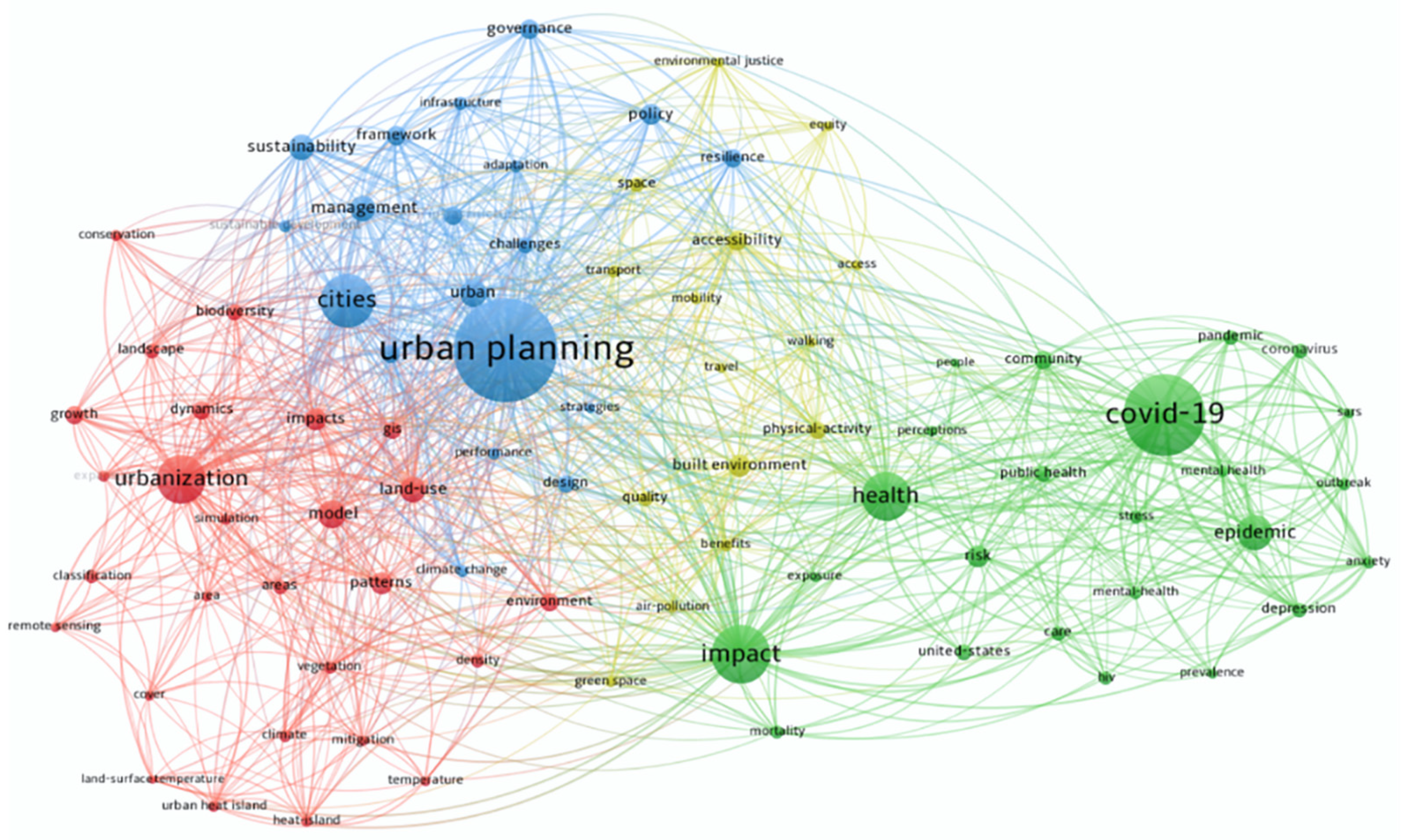
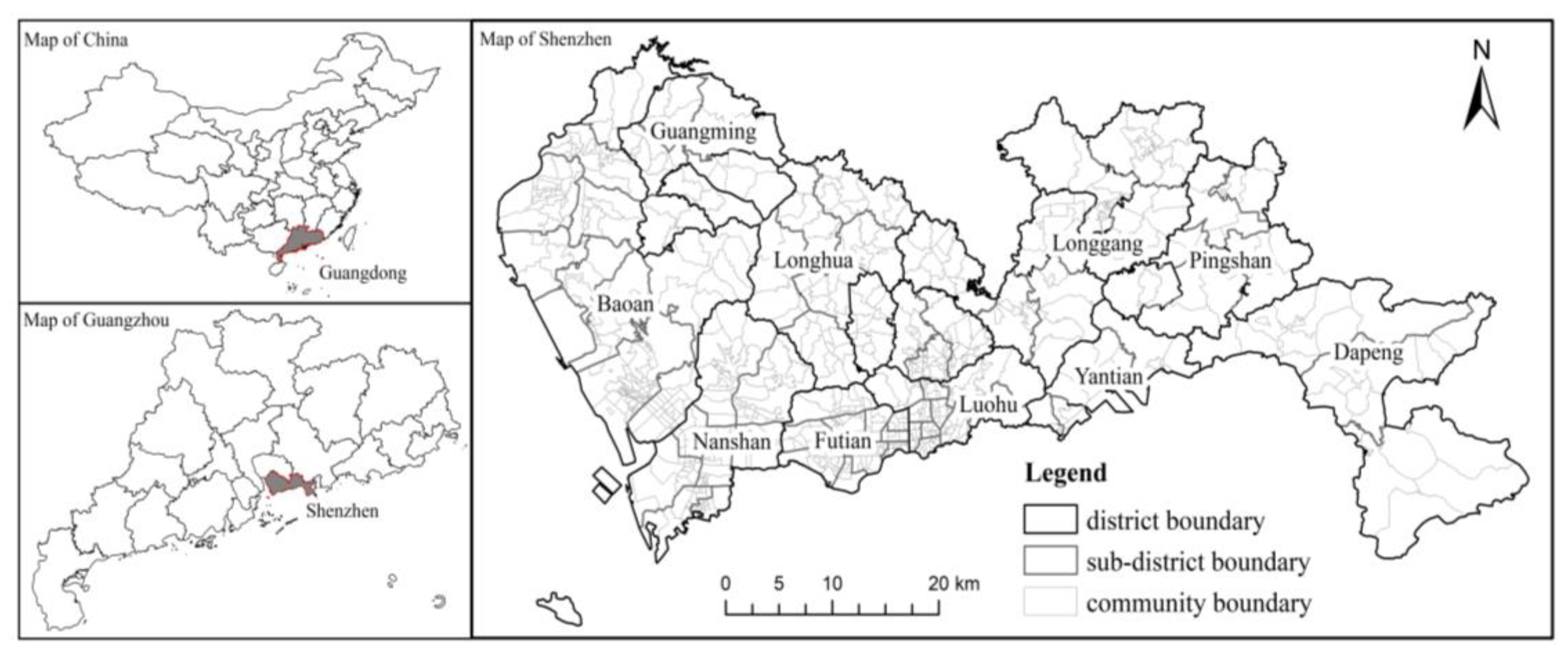
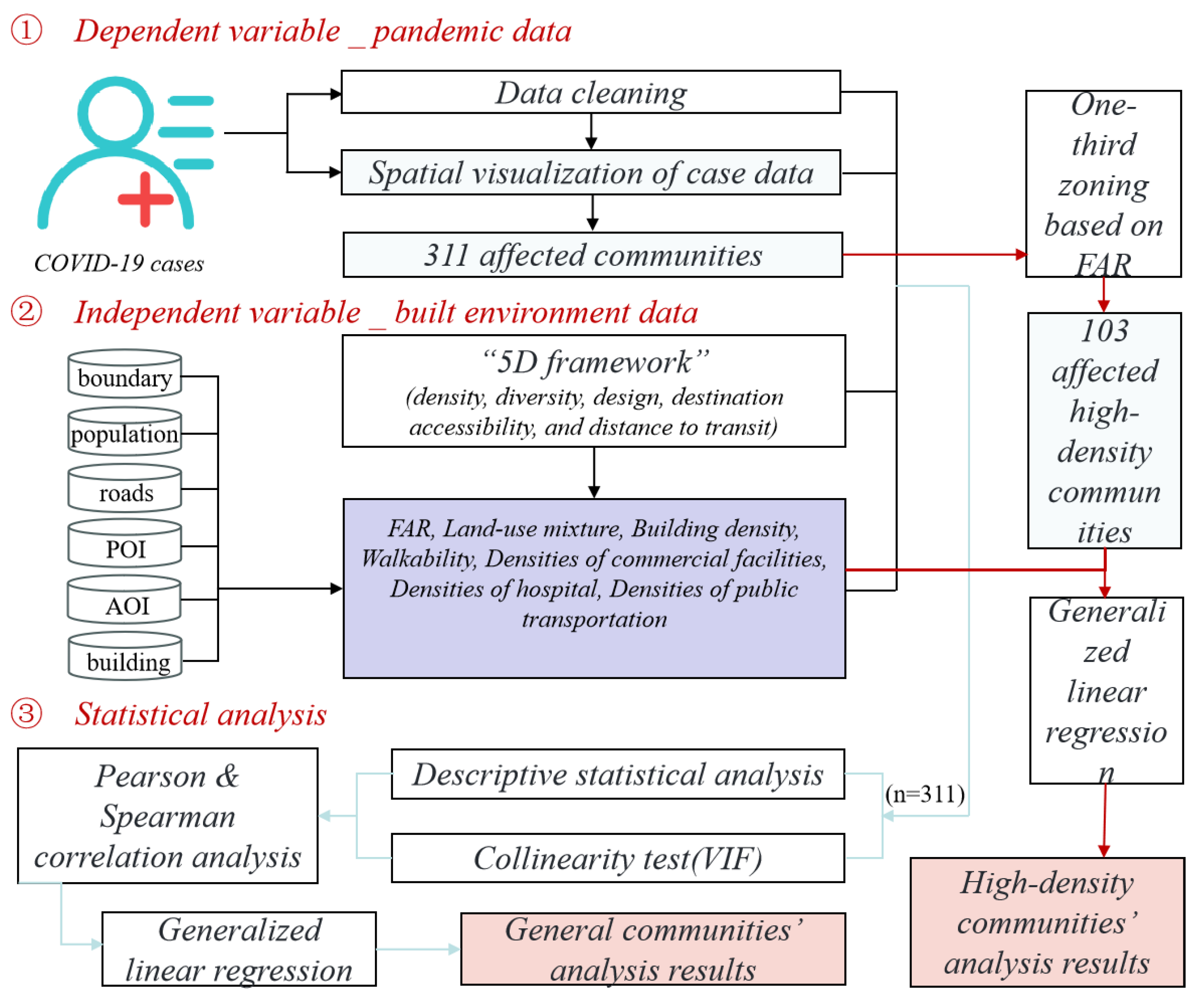

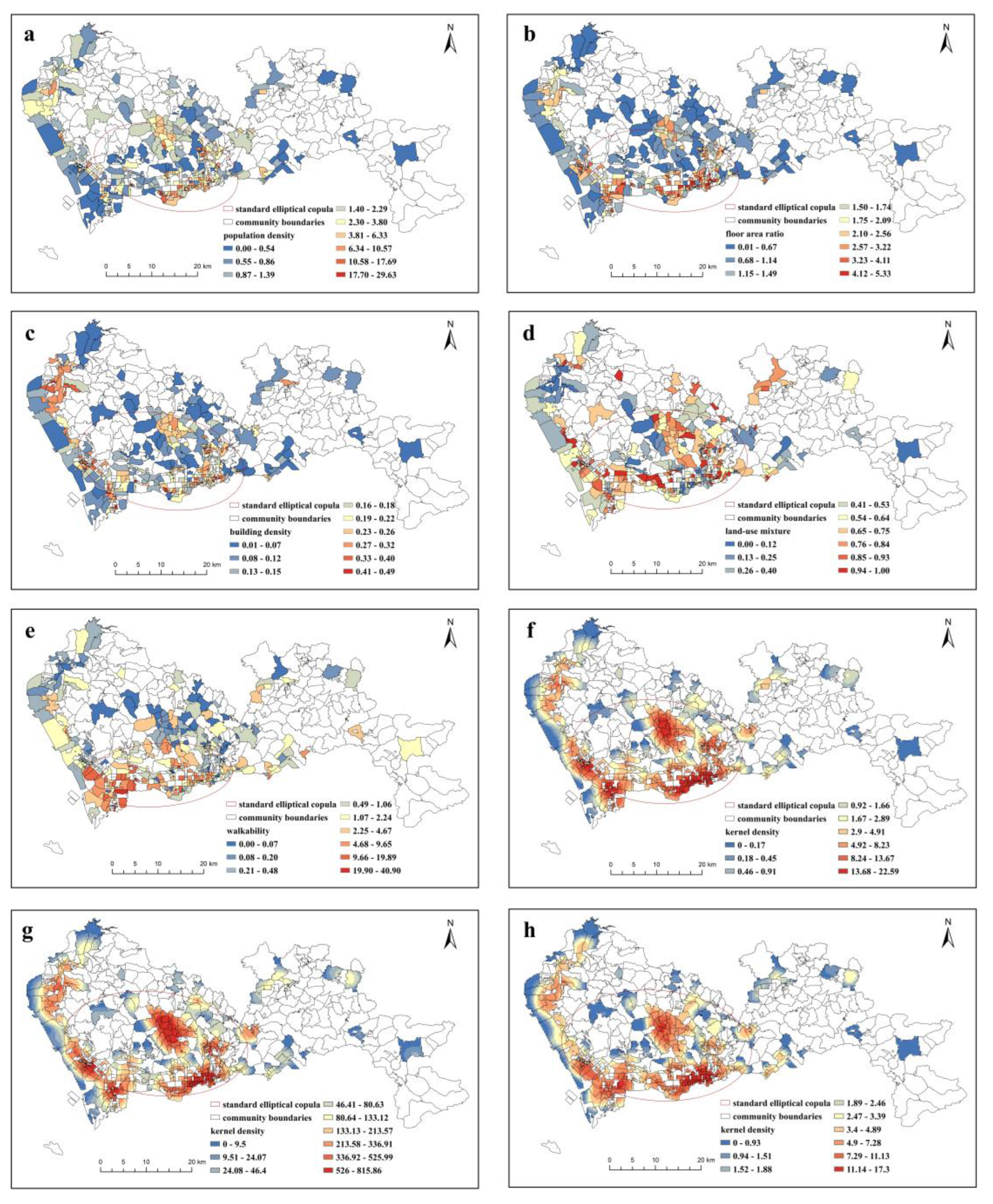
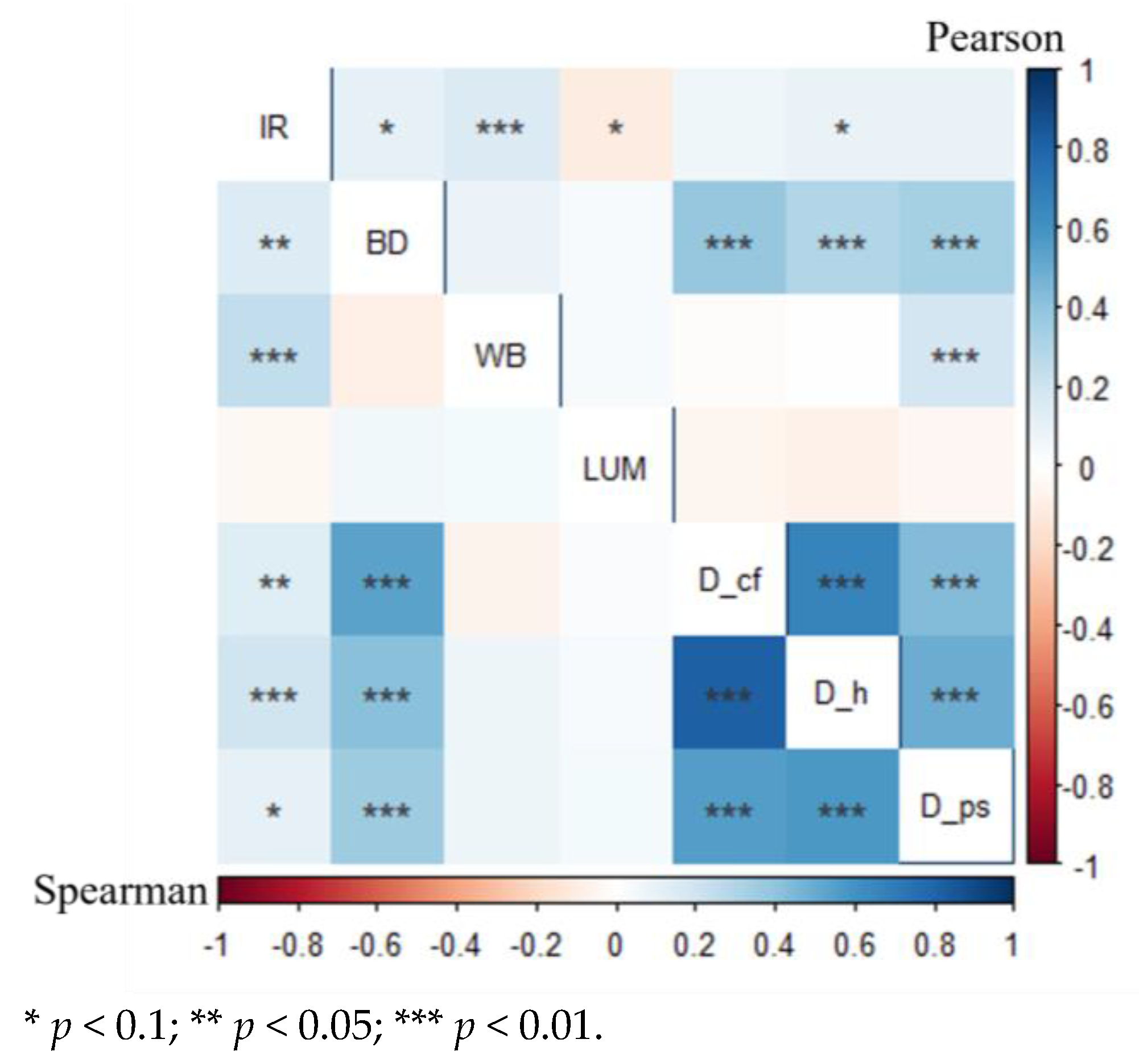

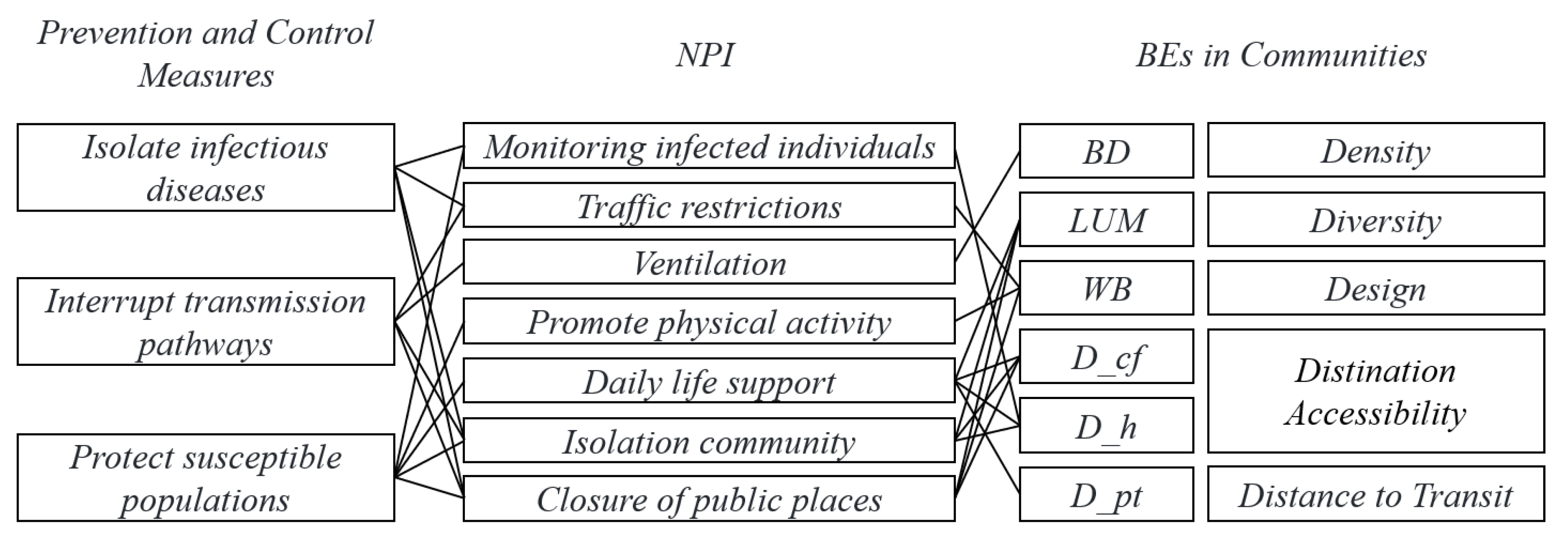
| Authors | Density | Diversity | Design | Destination Accessibility | Distance to Transit | |||||
|---|---|---|---|---|---|---|---|---|---|---|
| BD | FAR | LUM | RD | WB | OD | D_cf | D_h | D_gs | D_pt | |
| Behram Wali [35] | - | - | + | |||||||
| Shakil Bin Kashem et al. [36] | + | - | - | 0 | ||||||
| Quynh C. Nguyen [25] | + | |||||||||
| Tianming Zheng [20] | - | - | + | + | + | |||||
| Wu Li et al. [32] | + | - | + | - | + | |||||
| Xin Huang [37] | + | + | + | - | ||||||
| Tribby and Hartmann [22] | - | 0 | ||||||||
| Niu et al. [38] | + | + | + | - | + | |||||
| Credit [28] | - | + | ||||||||
| Guo, Yu and Zhang [23] | - | - | ||||||||
| Asfour [39] | + | |||||||||
| DiMaggio [40] | + | |||||||||
| Rahman [27] | 0 | + | + | |||||||
| Yong Xu et al. [41] | + | + | + | + | ||||||
| Bo Li et al. [31] | + | + | + | |||||||
| Emre Tepe [42] | + | |||||||||
| Zerun Liu et al. [43] | - | - | + | - | ||||||
| Jingwei Wang [19] | - | + | - | - | ||||||
| Eric Gaisie [44] | + | + | ||||||||
| Kate H. Choi [45] | - | + | ||||||||
| Dennis Schmiege [46] | - | - | ||||||||
| Indicator Name | Formula | Description | Data Source |
|---|---|---|---|
| BD | BD represents the building density, BA represents the base area of the community building, and CA represents the footprint of the community. | BA: Shenzhen’s building outline data from Baidu Maps; CA: Shenzhen Municipal Planning and Natural Resources Bureau’s Shenzhen City Map (Out-line Version III) | |
| LUM | pk represents the percentage of sites within K in each community, and N is the number of site types in the community. | AOI: Area of Interest data for Shenzhen from Baidu Maps; N: the number of AOI types | |
| WB | The width of sidewalk/bicycle lane is assumed to be normal. Lfw represents the length of the sidewalk in the community, Lcw represents the length of the bike lane in the community, and CA represents the footprint of the community. | The width of sidewalk/bicycle lane: obtained data from OpenStreetMap | |
| D_cf | Ncf represents the number of commercial facilities in the community, and CA represents the footprint of the community. | POI data obtained from Baidu Maps, including 150,514 commercial facilities, 3773 medical facilities, and 3529 public transportation stops | |
| D_h | Nh represents the number of medical facilities in the community, and CA represents the footprint of the community. | ||
| D_pt | Nps represents the number of public transportation stops in the community, and CA represents the footprint of the community. |
| Variable | Descriptive Statistics | Pearson | Spearman | Collinearity | ||||
|---|---|---|---|---|---|---|---|---|
| Mean | Std. Dev. | Coef. | p-Value | Coef. | p-Value | VIF | 1/VIF | |
| BD | 0.199 | 0.097 | 0.1048 * | 0.0650 | 0.1412 ** | 0.0127 | 1.24 | 0.807 |
| LUM | 0.570 | 0.293 | −0.1033 * | 0.0689 | −0.0318 | 0.5758 | 1.01 | 0.989 |
| WB | 2.860 | 4.594 | 0.1512 *** | 0.0076 | 0.2430 *** | <0.001 | 1.05 | 0.948 |
| D_cf | 529.794 | 641.605 | 0.0658 | 0.2476 | 0.1375 ** | 0.0152 | 1.95 | 0.513 |
| D_h | 14.350 | 16.053 | 0.0968 * | 0.0885 | 0.1934 *** | <0.001 | 1.99 | 0.503 |
| D_pt | 10.607 | 9.940 | 0.0916 | 0.1067 | 0.1009 * | 0.0755 | 1.48 | 0.675 |
| Variable | Poisson_F | Negative Binomial_F | Zero Truncated nb_F | ||||||
|---|---|---|---|---|---|---|---|---|---|
| Estimate | S.E. | p | Estimate | S.E. | p | Estimate | S.E. | p | |
| Intercept | 3.100 *** | 0.033 | <0.001 | 0.701 *** | 0.204 | <0.001 | 2.781 *** | 0.252 | <0.001 |
| BD | 1.671 *** | 0.122 | <0.001 | 1.685 ** | 0.766 | 0.027 | 1.846 ** | 0.916 | 0.044 |
| WB | 0.044 *** | 0.002 | <0.001 | 0.055 *** | 0.014 | <0.001 | 0.064 *** | 0.021 | 0.002 |
| LUM | −0.739 *** | 0.036 | <0.001 | −0.738 *** | 0.229 | 0.001 | −0.767 *** | 0.264 | 0.004 |
| D_h | 0.012 *** | 0.001 | <0.001 | 0.012 ** | 0.006 | 0.029 | 0.013 * | 0.007 | 0.052 |
| D_cf | −0.000 ** | 0.000 | 0.032 | −0.000 | 0.000 | 0.664 | −0.000 | 0.000 | 0.533 |
| D_pt | −0.005 *** | 0.001 | <0.001 | 0.000 | 0.008 | 0.970 | 0.002 | 0.009 | 0.817 |
| Deviance | 13,972.62 | 370.603 | 2573.4 | ||||||
| AIC | 15,343.665 | 1323.309 | 2589.388 | ||||||
| AICc | 15,344.035 | 1323.786 | 2589.865 | ||||||
| BIC | 15,369.844 | 1353.227 | 2619.306 | ||||||
| Variable | Poisson_H | Negative Binomial_H | Zero Truncated nb_H | ||||||
|---|---|---|---|---|---|---|---|---|---|
| Estimate | S.E. | p | Estimate | S.E. | p | Estimate | S.E. | p | |
| Intercept | 4.250 *** | 0.069 | <0.001 | 3.873 *** | 0.506 | <0.001 | 3.797 *** | 0.492 | <0.001 |
| BD | 0.530 ** | 0.225 | 0.018 | 1.072 | 1.511 | 0.489 | 1.123 | 1.784 | 0.529 |
| WB | 0.039 *** | 0.002 | <0.001 | 0.039 ** | 0.020 | 0.047 | 0.041 | 0.025 | 0.105 |
| LUM | −1.140 *** | 0.049 | <0.001 | −1.010 *** | 0.347 | 0.004 | −1.066 *** | 0.412 | 0.009 |
| D_h | 0.000 | 0.000 | 0.904 | 0.001 | 0.001 | 0.466 | 0.006 | 0.008 | 0.478 |
| D_cf | 0.000 | 0.000 | 0.330 | 0.000 | 0.000 | 0.878 | 0.000 | 0.000 | 0.835 |
| D_pt | −0.016 *** | 0.001 | <0.001 | −0.014 | 0.010 | 0.167 | −0.014 | 0.011 | 0.197 |
| Deviance | 7582.157 | 118.576 | 950 | ||||||
| AIC | 8091.276 | 977.801 | 965.963 | ||||||
| AICc | 8092.455 | 979.333 | 967.495 | ||||||
| BIC | 8109.719 | 998.879 | 987.041 | ||||||
Disclaimer/Publisher’s Note: The statements, opinions and data contained in all publications are solely those of the individual author(s) and contributor(s) and not of MDPI and/or the editor(s). MDPI and/or the editor(s) disclaim responsibility for any injury to people or property resulting from any ideas, methods, instructions or products referred to in the content. |
© 2023 by the authors. Licensee MDPI, Basel, Switzerland. This article is an open access article distributed under the terms and conditions of the Creative Commons Attribution (CC BY) license (https://creativecommons.org/licenses/by/4.0/).
Share and Cite
Hu, Y.; Lin, Z.; Jiao, S.; Zhang, R. High-Density Communities and Infectious Disease Vulnerability: A Built Environment Perspective for Sustainable Health Development. Buildings 2024, 14, 103. https://doi.org/10.3390/buildings14010103
Hu Y, Lin Z, Jiao S, Zhang R. High-Density Communities and Infectious Disease Vulnerability: A Built Environment Perspective for Sustainable Health Development. Buildings. 2024; 14(1):103. https://doi.org/10.3390/buildings14010103
Chicago/Turabian StyleHu, Yue, Ziyi Lin, Sheng Jiao, and Rongpeng Zhang. 2024. "High-Density Communities and Infectious Disease Vulnerability: A Built Environment Perspective for Sustainable Health Development" Buildings 14, no. 1: 103. https://doi.org/10.3390/buildings14010103
APA StyleHu, Y., Lin, Z., Jiao, S., & Zhang, R. (2024). High-Density Communities and Infectious Disease Vulnerability: A Built Environment Perspective for Sustainable Health Development. Buildings, 14(1), 103. https://doi.org/10.3390/buildings14010103







